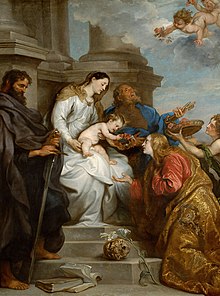September 4th
| Image via Wikipedia |
FERIAL DAY
(Mass of preceding Sunday)
[Requiem or Votive Mass allowed]
SAINT ROSALIA
Virgin (1166 A.D.)
[Historical, Patron of Palermo, Sicily]

Daughter of Sinibald, Lord of Roses, and Quisquina. Descendant of Charlemagne. From her
youth, Rosalia knew she was called to dedicate her life to God. When grown, she moved to cave near her parent's home, and lived in it the rest of her life. On the cave wall she wrote "I, Rosalia, daughter of Sinibald, Lord of Roses, and Quisquina, have taken the resolution to live in this cave for the love of my Lord, Jesus Christ." Rosalia remained apart from the world, dedicated to prayer and works of penance for the sake of Jesus, and died alone.
SAINT ROSE OF VITERBO
Virgin (1252 A.D.)
[Historical]
SAINT MARINUS
Hermit (4th C.)
[Historical]
SAINT ROSALIA
Virgin (1166 A.D.)
[Historical, Patron of Palermo, Sicily]

(Wikipedia) Santa Rosalia, depicted on the right, before St. Mary by Anthony van Dyck
Daughter of Sinibald, Lord of Roses, and Quisquina. Descendant of Charlemagne. From her
youth, Rosalia knew she was called to dedicate her life to God. When grown, she moved to cave near her parent's home, and lived in it the rest of her life. On the cave wall she wrote "I, Rosalia, daughter of Sinibald, Lord of Roses, and Quisquina, have taken the resolution to live in this cave for the love of my Lord, Jesus Christ." Rosalia remained apart from the world, dedicated to prayer and works of penance for the sake of Jesus, and died alone.
In 1625, during a period of plague, she appeared in a vision to a
hunter near her cave. Her relics were discovered, brought to Palermo,
and paraded through the street. Three days later the plague ended,
intercession to Rosalia was credited with saving the city, and she was
proclaimed its patroness.
SAINT ROSE OF VITERBO
Virgin (1252 A.D.)
[Historical]
Virgin, born at Viterbo, 1235; died 6 March, 1252. The chronology of her life must always remain uncertain, as the Acts of her canonization, the chief historical sources, record no dates. Those given above are accepted by the best authorities.
Born of poor and pious parents, Rose was remarkable for holiness and for her miraculous powers from her earliest years. When but three years old, she raised to life her maternal aunt. At the age of seven, she had already lived the life of a recluse, devoting herself to penances. Her health succumbed, but she was miraculously cured by the Blessed Virgin, who ordered her to enroll herself in the Third Order of St. Francis, and to preach penance to Viterbo, at that time (1247) held by Frederick II of Germany and a prey to political strife and heresy. Her mission seems to have extended for about two years, and such was her success that the prefect of the city decided to banish her. The imperial power was seriously threatened. Accordingly, Rose and her parents were expelled from Viterbo in January, 1250, and took refuge in Sorriano. On 5 December, 1250, Rose foretold the speedy death of the emperor, a prophecy realized on 13 December. Soon afterwards she went to Vitorchiano, whose inhabitants had been perverted by a famous sorceress. Rose secured the conversion of all, even of the sorceress, by standing unscathed for three hours in the flames of a burning pyre, a miracle as striking as it is well attested. With the restoration of the papal power in Viterbo (1251) Rose returned.
She wished to enter the monastery of St. Mary of the Roses, but was refused because of her poverty. She humbly submitted, foretelling her admission to the monastery after her death. The remainder of her life was spent in the cell in her father's house, where she died. The process of her canonization was opened in that year by Innocent IV, but was not definitively undertaken until 1457. Her feast is celebrated on 4 September, when her body, still incorrupt, is carried in procession through Viterbo.
SAINT MARINUS
Hermit (4th C.)
[Historical]
Saint Marinus was the founder of the world's oldest surviving republic, San Marino, in 301. Tradition holds that he was a stonemason by trade who came from the island of Rab on the other side of the Adriatic Sea (modern Croatia), fleeing persecution for his Christian beliefs in the Diocletianic Persecution. He became a Deacon, and was ordained by Gaudentius, the Bishop of Rimini, until he was accused by an insane woman of being her estranged husband, when he fled to Monte Titano to live as a hermit.[1]
There he built a chapel and monastery. Marines were canonized and later,
the State of San Marino grew up from the center created by the
monastery.[1] His memorial day is September 3, commemorating the day of the year when he founded San Marino, which is also the state's national holiday.
According to legend, he died in the Winter of 366 and his last words were: "Relinquo vos liberos ab utroque homine."
("I leave you free from both men"). This somewhat mysterious phrase is
most likely to refer to the two "men" from whose oppressive power Saint
Marinus had decided to separate himself, becoming a hermit on Mount
Titano: respectively the Emperor and the Pope. This affirmation of
freedom (first and foremost fiscal franchise) from both the Empire and the Papal States, however legendary, has always been the inspiration of the tiny republic.[2]
No comments:
Post a Comment
Please no anonymous comments. I require at least some way for people to address each other personally and courteously. Having some name or handle helps.
Note: Only a member of this blog may post a comment.